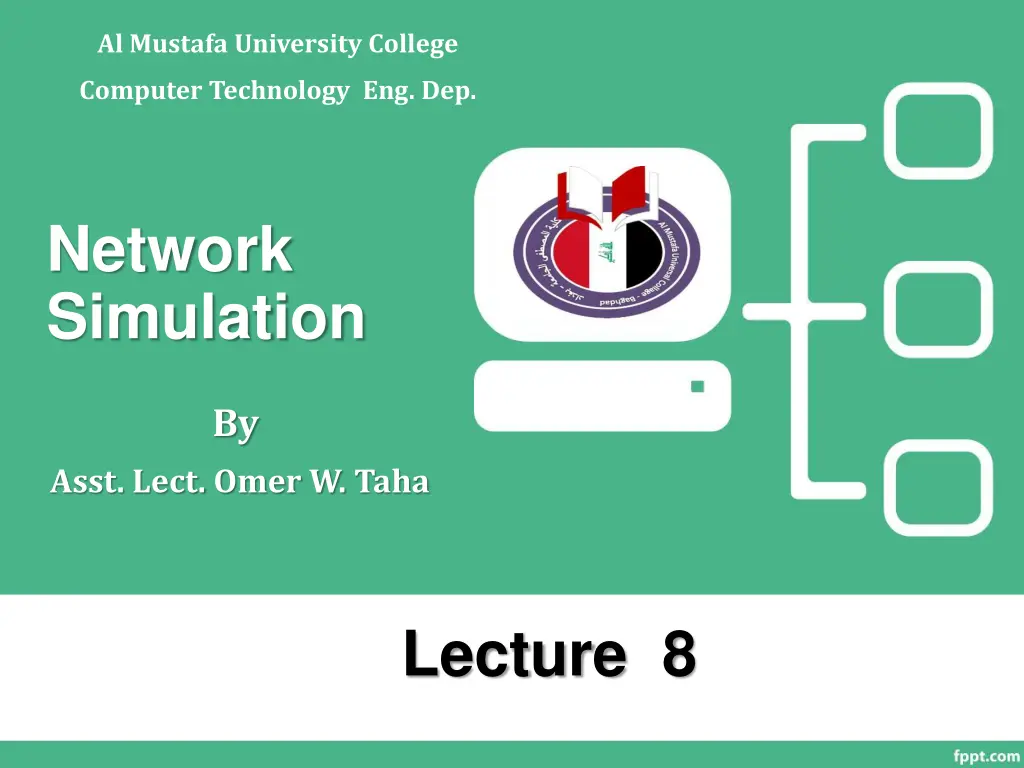
Understanding Subnet Masking and CIDR in Network Simulation
Explore the concept of subnet masking in networking, including how to determine subnet masks, CIDR notation, default subnet masks, and subnetting examples. Learn the essentials of establishing subnet masks and gain insight into subnetting. Enhance your understanding of network design and address allocation for efficient communication.
Download Presentation

Please find below an Image/Link to download the presentation.
The content on the website is provided AS IS for your information and personal use only. It may not be sold, licensed, or shared on other websites without obtaining consent from the author. If you encounter any issues during the download, it is possible that the publisher has removed the file from their server.
You are allowed to download the files provided on this website for personal or commercial use, subject to the condition that they are used lawfully. All files are the property of their respective owners.
The content on the website is provided AS IS for your information and personal use only. It may not be sold, licensed, or shared on other websites without obtaining consent from the author.
E N D
Presentation Transcript
Al Mustafa University College Computer Technology Eng. Dep. Network Simulation By Asst. Lect. Omer W. Taha Lecture 8
SubnetMask Determines which part of an IP address is the network field and whichpart is the hostfield Follow these steps to determine the subnetmask: 1. Express the sub network IP address in binaryform. 2. Replace the network and subnet portion of the address with all1s. 3. Replace the host portion of the address with all0s. 4. Convert the binary expression back to dotted-decimalnotation.
SubnetMask Subnet mask in decimal = 255.255.240.0
Subnetting Host bits must are reassigned (or borrowed ) as network bits. The starting point is always the leftmost host bit. 3 bits borrowed allows 23-2 or 6 subnets 5 bits borrowed allows 25-2 or 30 subnets 12 bits borrowed allows 212-2 or 4094 subnets
subnetmask:CIDR CIDR: Classless Inter Domain Routing subnet portion of address of arbitrary length address format: a.b.c.d/x, where x is # of bits in subnet portion of address (1s) only We will explain this in detail in later subnet part host part 11001000 00010111 00010000 00000000 200.23.16.0/23
Sub netting chart table Mask 128 64 32 16 8 4 2 1 Sub net maskvalue 128+64+ 32=224 128 128+64 =192 224 240 248 252 254 NetMask CA/8 /9 /10 /11 /12 /13 /14 /15 /16 NetMask CA/16 /17 /18 /19 /20 /21 /22 /23 /24 NetMask CA/24 /25 /26 /27 /28 /29 /30 /31 /32
Establishing the Subnet Mask Address To determine the number of bits to be used, the network designer needs to calculate how many hosts the largest subnetwork requires and the number of subnetworks needed. The slash format is a shorter way of representing the subnetmask: /25 represents the 25 one bits in the subnet mask 255.255.255.128
Subnetting Examlpes What is the subnet mask value for 255.255.255.0? its class C then for /25 =128, /26=192 etc.. Read sub net mask value for /18,/22,/11? For /18 its class B then due to table the mask is 255.255.192.0 For /22 its class B then due to table the mask is 255.255.252.0 For /11 its class A then due to table the mask is 255.244.0.0
Determining subnet Example: network = 192.168.10.0/26 class c. then from table /26= 64 step i.e. 0-64-128. then 1= 2= 2 subnet can be determined from this IP Exercise: determine subnet from network 192.168.10.0/20? 192.168.10.0 192.168.10.64 192.168.10.128
Subnetting Class C Addresses In a Class C address, only 8 bits are available for defining the hosts. Remember that subnet bits start at the left and go to the right, without skipping bits. This means that the only Class C subnet masks can be the following: Binary --------------------------------------------------------- 10000000 = 128 /25 11000000 = 192 /26 11100000 = 224 /27 11110000 = 240 /28 11111000 = 248 /29 11111100 = 252 /30 Decimal CIDR
Calculating the Subnetwork With ANDing ANDing is a binary process by which the router calculates the subnetwork ID for an incomingpacket. 1 AND 1 = 1; 1 AND 0 = 0; 0 AND 0 = 0 The router then uses that information to forward the packet across the correct interface. Packet Address 192.168.10.65 11000000.10101000.00001010.010 00001 Subnet Mask 255.255.255.224 11111111.11111111.11111111.111 00000 Subnetwork Address 192.168.10.64 11000000.10101000.00001010.010 00000
How Many Subnets? 22 = number ofsubnets. X is the number of masked bits, or the 1s. For example, in 11000000, the number of ones gives us 22subnets. In this example there are 4 subnets.
How Many Hosts Per Subnet? 2y-2 = number of hosts per subnet. Y is the number of unmasked bits, or the 0s. For example, in 11000000, the number of zeros gives us 26-2 hosts. In this example, there are 62 hosts per subnet.
